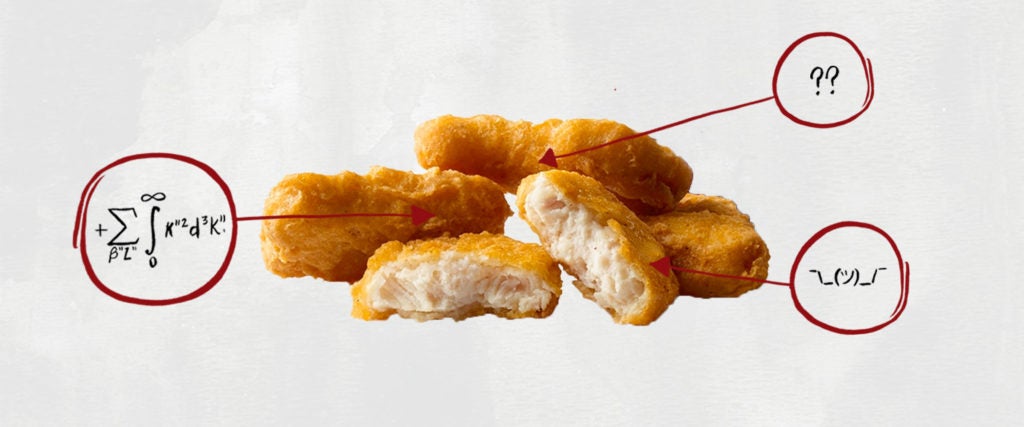So you want to know what’s in McDonald’s Chicken McNuggets? This is among the scariest culinary questions you can ever ask, right up there with what’s really in hot dogs, although any fan of The Simpsons worth a damn knows the answer to that question already: It’s a mixture of raccoon feet, pigeon heads, rat tails and the tongues of old leather shoes. Hopefully the ingredients of the McNugget will be a little more comestible.
Had you asked this same question just half a decade earlier, the answer to it would have varied slightly. In 2016, McDonald’s changed the recipe of the Chicken McNugget, albeit ever so slightly, to eliminate the preservatives dimethylpolysiloxane and TBHQ from the McNugget-making process. Nowadays, citric acid is the sole preservative that remains present in the McAmalgamation that continues to be labeled as a McNugget.
Now that we’ve got that out of the way, let’s see what’s lurking both inside and outside of these 45-calorie chunks of chicken.
The Chicken McNugget
1) White Boneless Chicken: I know you’re relieved (and possibly surprised) to see this. McDonald’s Chicken McNuggets have been dogged by claims of being composed of bona fide mystery meat for years. When Morgan Spurlock’s 2004 documentary Super Size Me was released, it had many McFans wishing the meat had maintained its mysteriousness after Spurlock alleged that the chicken in McNuggets is lopped off the breasts of mutant chicken before being pressed into family-friendly shapes.
2) Water: Probably different from the type that comes out of the soft-drink dispenser.
3) Vegetable Oil (Canola Oil, Corn Oil, Soybean Oil): Vegetable oil is fine in moderation, but there is growing suspicion that consuming it in high doses could contribute to the very same heart disease that vegetable oil was thought to protect against. Fun fact about canola oil: It stands for “Canada oil low acid,” which was a term cooked up by researchers because they didn’t want to refer to it by what it really is — a derivative of rapeseed. Understandably, no one wanted to sell an oil that had “rape” as a root word.
4) Enriched Flour (Bleached Wheat Flour, Niacin, Reduced Iron, Thiamine Mononitrate, Riboflavin, Folic Acid): Flour “enrichment” is essentially the Bizarro World practice of eliminating much of flour’s nutrients by eliminating the bran and the germ. This extends the flour’s shelf-life, but renders it substantially less nutritious.
5) Bleached Wheat Flour: Don’t be too scared by the use of the “B” word; all flour is bleached. It naturally bleaches itself as it ages. In this case, however, “bleaching” refers to the process of accelerating the aging of the flour in order to give it a softer texture, which also depletes its vitamin E.
6) Yellow Corn Flour: A corn-based flour used to provide additional structure to baked goods.
7) Vegetable Starch (Modified Corn, Wheat, Rice, Pea, Corn): Vegetable starches can serve a variety of purposes, and are often used for their cohesive properties to bind things together. In fact, vegetable starches can be so cohesive that you could essentially use them to create biodegradable plastic bags if you really wanted to.
8) Salt: The median size McNuggets offering (I’m stunned that you can order a 40-piece version!) contains 10 pieces, and that comes infused with 1,155 milligrams of sodium, which is 49 percent of the recommended daily intake for most people. That’s a hefty amount of sodium to acquire from a single fast-food entrée.
9) Leavening (Baking Soda, Sodium Aluminum Phosphate, Sodium Acid Pyrophosphate, Calcium Lactate, Monocalcium Phosphate): Also known as baking soda, sodium bicarbonate produces carbon dioxide, which helps the dough — or breading, in this case — rise. Sodium aluminum sulfate reacts with sodium bicarbonate to help produce that carbon dioxide.
10) Spices: Under the rules of the FDA, food labelers enjoy what amounts to trade-secret protection for the spice blends used in their recipes. Unlike patents, trade secrets don’t require the publication of their specific details, aren’t limited by time (patents are protected for a maximum of 20 years) and require no registration costs. In order to qualify, the spice included simply needs to adhere to the governmentally definition of the word “spice”:
“The term spice means any aromatic vegetable substance in the whole, broken or ground form, except for those substances which have been traditionally regarded as foods, such as onions, garlic and celery; whose significant function in food is seasoning rather than nutritional; that is true to name; and from which no portion of any volatile oil or other flavoring principle has been removed.”
11) Yeast Extract: This is used to add a savory taste to food. Some have described it as being akin to the flavor of umami.
12) Lemon Juice Solids: This is essentially a powdery, crystalized version of lemon juice that has a five-year shelf-life, eliminating the need to keep fresh lemons lying around. Just add water.
13) Dextrose: Dextrose is a sugar derived from starches, like corn, and is chemically identical to glucose, or blood sugar. Because of this, dextrose is also used medically to treat low blood sugar and dehydration, and is theorized to help offset sugar imbalances in the intestines.
14) Natural Flavors: Natural flavors are quite literally flavors derived from their legitimate food sources , which means McDonald’s might be infusing their chicken with the additional essence of chicken.
The Takeaway
Honestly, 14 ingredients sounds pretty darn excessive for what’s supposed to be, at its core, a breaded piece of chicken. And just think, we haven’t even selected a dipping sauce yet!

